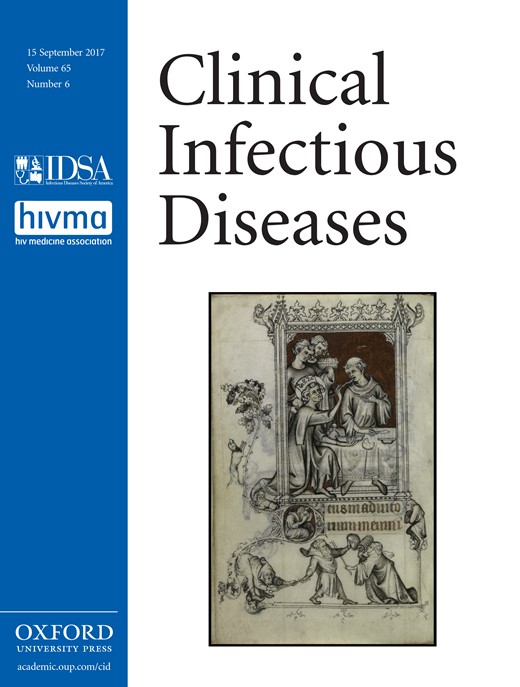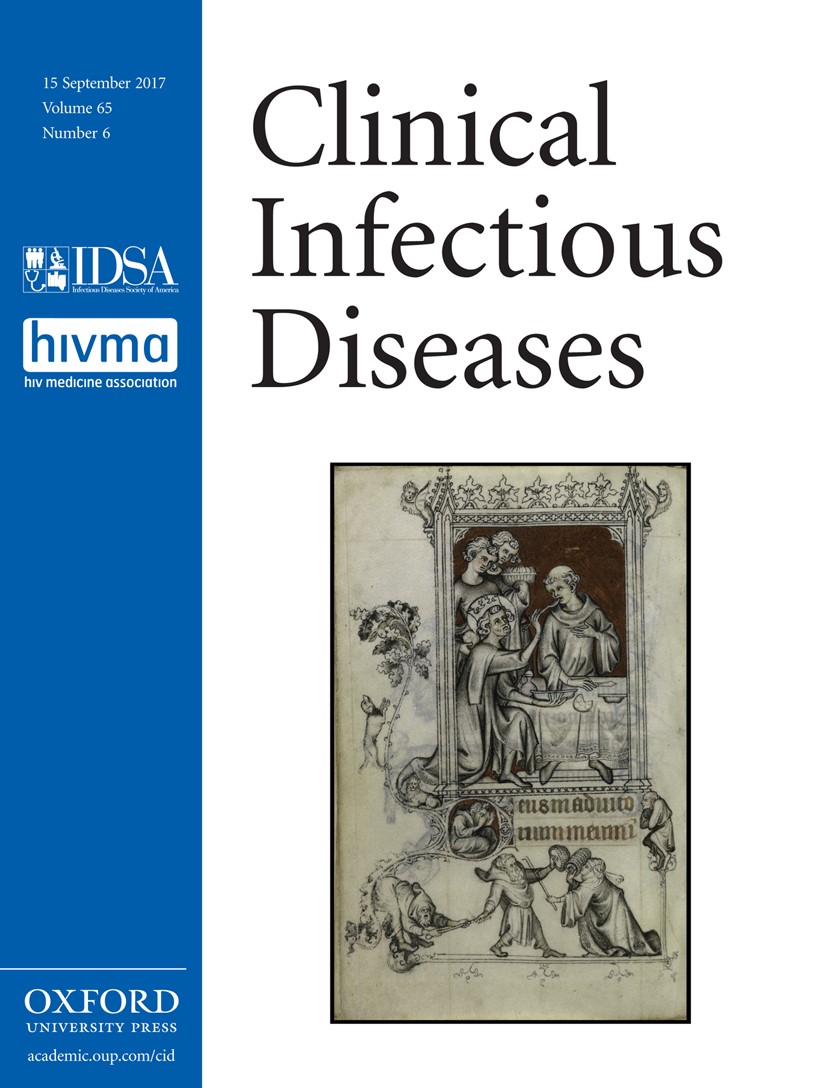
Cover image

Volume 65, Issue 6, 15 September 2017
NEWS
News
IN THE LITERATURE
In the Literature
ARTICLES AND COMMENTARIES
Maternal Zika Virus Disease Severity, Virus Load, Prior Dengue Antibodies, and Their Relationship to Birth Outcomes
Maternal Zika symptom severity or ZIKA-RNA load at time of infection did not impact birth outcomes in our cohort analysis. Presence of prior maternal dengue antibodies had no effect on Zika infection severity, RNA load, or birth outcomes.
Declines in Human Papillomavirus (HPV)–Associated High-Grade Cervical Lesions After Introduction of HPV Vaccines in Connecticut, United States, 2008–2015
Significant declines in high-grade cervical lesions have occurred among young women since 2008. The age and cohort patterns in declines suggest they are more likely driven by human papillomavirus vaccination than by changes in screening or risk behaviors.
Maximizing the Impact of Human Papillomavirus Vaccination
Age of Acquiring Causal Human Papillomavirus (HPV) Infections: Leveraging Simulation Models to Explore the Natural History of HPV-induced Cervical Cancer
Although new HPV infections and associated precancers can occur throughout a woman’s lifetime, only a small proportion are acquired in mid-adult women and are vaccine-preventable. Our model-based explorations provide insight into causal HPV infections and highlight the potential limitations of using surrogate endpoints for vaccine efficacy studies of mid-adult women to guide policy decisions for implementation.
Impact of Vitamin A and Carotenoids on the Risk of Tuberculosis Progression
Vitamin A deficiency was associated with a 10-fold increase in risk of developing TB disease after household exposure. Vitamin A supplementation among high risk individuals might represent an effective means of preventing progression from TB infection to TB disease.
Management of Bacteriuria in Veterans Affairs Hospitals
The majority of bacteriuria among inpatient Veterans represents asymptomatic bacteriuria with a large proportion of patients unnecessarily treated with prolonged durations of therapy for both asymptomatic bacteriuria and symptomatic urinary tract infections.
Cluster of Neisseria gonorrhoeae Isolates With High-level Azithromycin Resistance and Decreased Ceftriaxone Susceptibility, Hawaii, 2016
We report on a cluster of Neisseria gonorrhoeae isolates identified on Oahu, Hawaii, that demonstrate high-level azithromycin resistance and decreased ceftriaxone susceptibility. Continued mutation and widespread emergence of such strains may severely complicate gonorrhea treatment.
Continued Evolution of Gonococcal Antimicrobial Resistance
Microbiological Persistence in Patients With Mycobacterium avium Complex Lung Disease: The Predictors and the Impact on Radiographic Progression
About 60% of patients with Mycobacterium avium complex lung disease had microbiological persistence >1 year, indicating a 3-fold increased risk for radiographic progression. Low body mass index, nodular-bronchiectatic radiographic pattern, and high acid-fast bacilli smear grade significantly predicted microbiological persistence.
Control of Multidrug-Resistant Pseudomonas aeruginosa in Allogeneic Hematopoietic Stem Cell Transplant Recipients by a Novel Bundle Including Remodeling of Sanitary and Water Supply Systems
Through major reconstruction of the water and sanitary system, we were able to significantly reduce the burden of Pseudomonas aeruginosa infections and colonizations in allogeneic hematopoietic stem cell transplant recipients as a high-risk patient group.
Neurosyphilis Increases Human Immunodeficiency Virus (HIV)-associated Central Nervous System Inflammation but Does Not Explain Cognitive Impairment in HIV-infected Individuals With Syphilis
Compared to those without cognitive impairment, HIV-infected individuals with syphilis who were cognitively impaired had higher CSF concentrations of mediators associated with HIV-related cognitive impairment.
Obesity and Diabetes as Risk Factors for Severe Plasmodium falciparum Malaria: Results From a Swedish Nationwide Study
In this nationwide observational study of 937 adults diagnosed with Plasmodium falciparum malaria in Sweden, Charlson comorbidity score ≥1 as well as diabetes and obesity were significantly associated with severe malaria in both nonimmune travelers and immigrants from endemic countries.
CD4:CD8 Ratio and CD8 Count as Prognostic Markers for Mortality in Human Immunodeficiency Virus–Infected Patients on Antiretroviral Therapy: The Antiretroviral Therapy Cohort Collaboration (ART-CC)
Associations of CD4:CD8 ratio or CD8 count with all-cause and cause-specific mortality were too small for them to be useful as independent prognostic markers in addition to CD4 count in virally suppressed patients on antiretroviral therapy with high CD4 count.
Serum LL-37 Levels Associated With Severity of Bronchiolitis and Viral Etiology
Among infants hospitalized with bronchiolitis, low serum LL-37 levels were independently associated with intensive care use and longer length-of-stay. Low levels of serum LL-37 were also independently associated with respiratory syncytial virus. By contrast, high LL-37 levels were associated with rhinovirus.
Early Acquisition of Pneumocystis jirovecii Colonization and Potential Association With Respiratory Distress Syndrome in Preterm Newborn Infants
This is the first research to evaluate Pneumocystis jirovecii colonization in preterm births, showing it is a frequent occurrence that could be a risk factor until now unknown to develop respiratory distress syndrome among preterm infants.
Birth Weight and Preterm Delivery Outcomes of Perinatally vs Nonperinatally Human Immunodeficiency Virus-Infected Pregnant Women in the United States: Results From the PHACS SMARTT Study and IMPAACT P1025 Protocol
Overall lack of association between maternal perinatal human immunodeficiency virus (HIV) infection and preterm delivery or infant birth weight (BW) is reassuring. The higher rates of low BW observed in older women with perinatally acquired HIV may warrant further investigations.
A Population-Based Assessment of the Impact of 7- and 13-Valent Pneumococcal Conjugate Vaccines on Macrolide-Resistant Invasive Pneumococcal Disease: Emergence and Decline of Streptococcus pneumoniae Serotype 19A (CC320) With Dual Macrolide Resistance Mechanisms
Macrolide-resistant Streptococcus pneumoniae containing both mef(E)/mel and erm(B) rapidly expanded (2005–2009) but decreased following pneumococcal conjugate vaccine 13 introduction. Macrolide-resistant serotypes not represented in vaccines increased modestly. Selective pressures of macrolide use and vaccine introductions were associated with these changes.
Spontaneous Viral Load Decline and Subsequent Clearance of Chronic Hepatitis C Virus in Postpartum Women Correlates With Favorable Interleukin-28B Gene Allele
Spontaneous resolution of chronic hepatitis C virus (HCV) infection is a rare event. We describe spontaneous resolution in 26.9% of a cohort of HCV-infected women by 12-months post-partum. Understanding the underlying immunological changes in similar cohorts could inform immune therapies and vaccine development.
Effect of Paritaprevir/Ritonavir/Ombitasvir/Dasabuvir and Ledipasvir/Sofosbuvir Regimens on Survival Compared With Untreated Hepatitis C Virus–Infected Persons: Results From ERCHIVES
In a study of 1473 persons on paritaprevir/ritonavir, ombitasvir, dasabuvir (PrOD), 5497 on ledipasvir/sofosbuvir (LDV/SOF), and 6970 propensity score–matched untreated persons, treatment with LDV/SOF or PrOD was associated with a 57% reduction in mortality. Benefit was apparent within the first 18 months of treatment.
Changes in Liver Steatosis After Switching From Efavirenz to Raltegravir Among Human Immunodeficiency Virus–Infected Patients With Nonalcoholic Fatty Liver Disease
Antiretroviral drugs less likely to induce steatosis progression are needed. In this clinical trial, we found that switching efavirenz by raltegravir was associated with decreases in steatosis among HIV-infected patients with nonalcoholic fatty liver disease.
VIEWPOINTS
Identifying Gaps in Respiratory Syncytial Virus Disease Epidemiology in the United States Prior to the Introduction of Vaccines
With the development of respiratory syncytial virus (RSV) vaccines, monoclonal antibodies, and antivirals, unanswered questions regarding RSV epidemiology need to be identified and addressed prior to introduction of vaccines and RSV therapeutics to guide the measurement of impact and future recommendations.
REVIEW ARTICLE
Rapid Tests for Influenza, Respiratory Syncytial Virus, and Other Respiratory Viruses: A Systematic Review and Meta-analysis
This meta-analysis evaluates the diagnostic accuracy of rapid tests for the detection of respiratory viruses. Sensitivity of tests varied considerably, but specificity was high. Although newly developed tests seem more sensitive, high quality evaluations of these tests are lacking.



